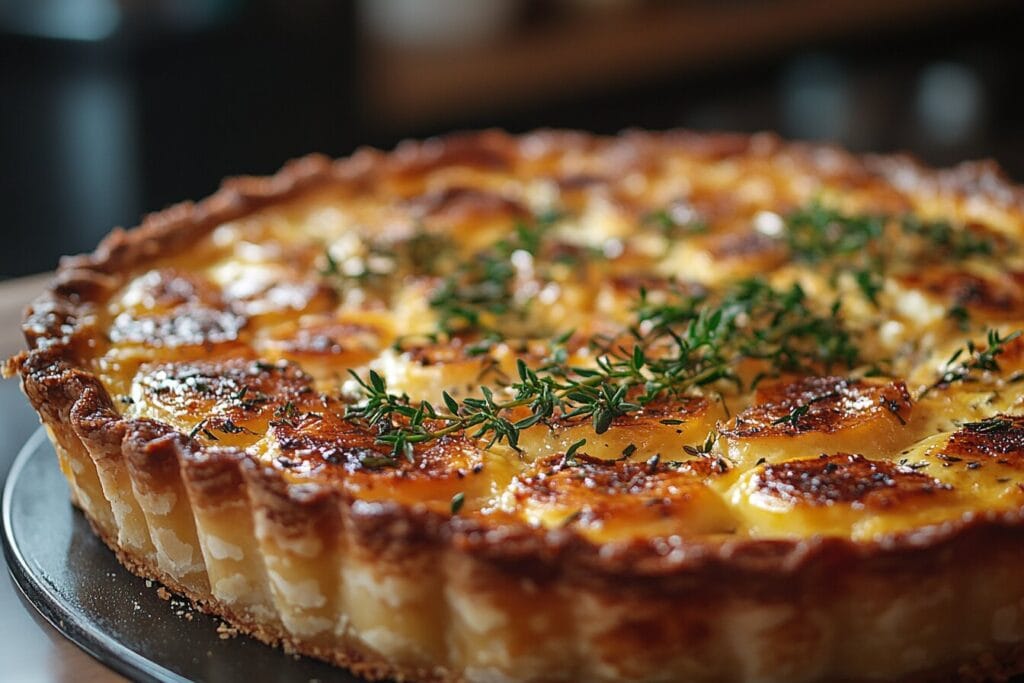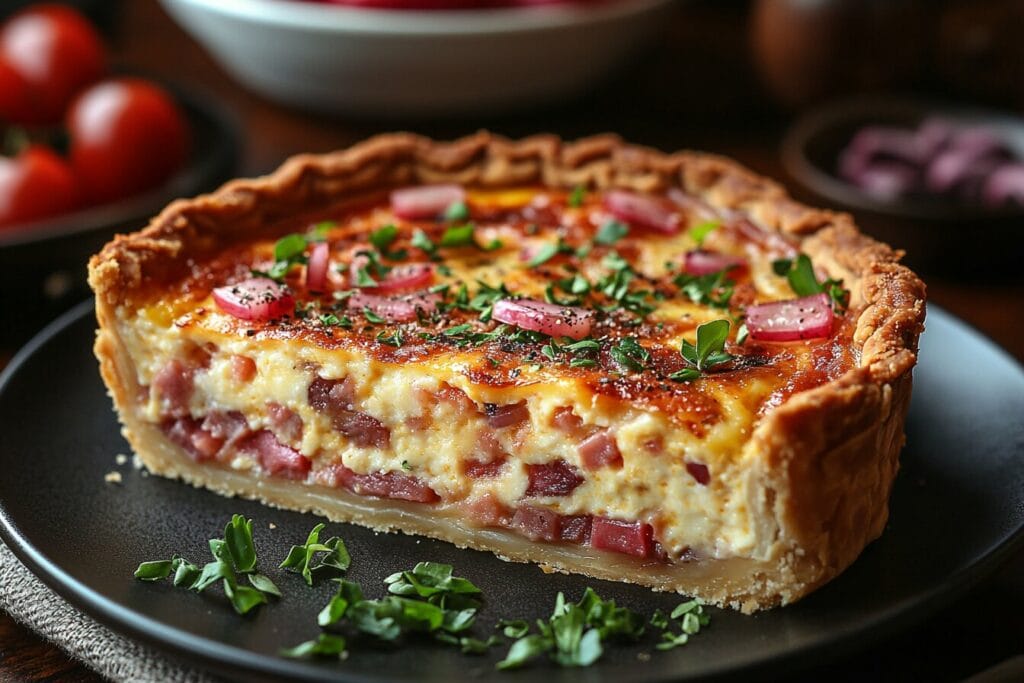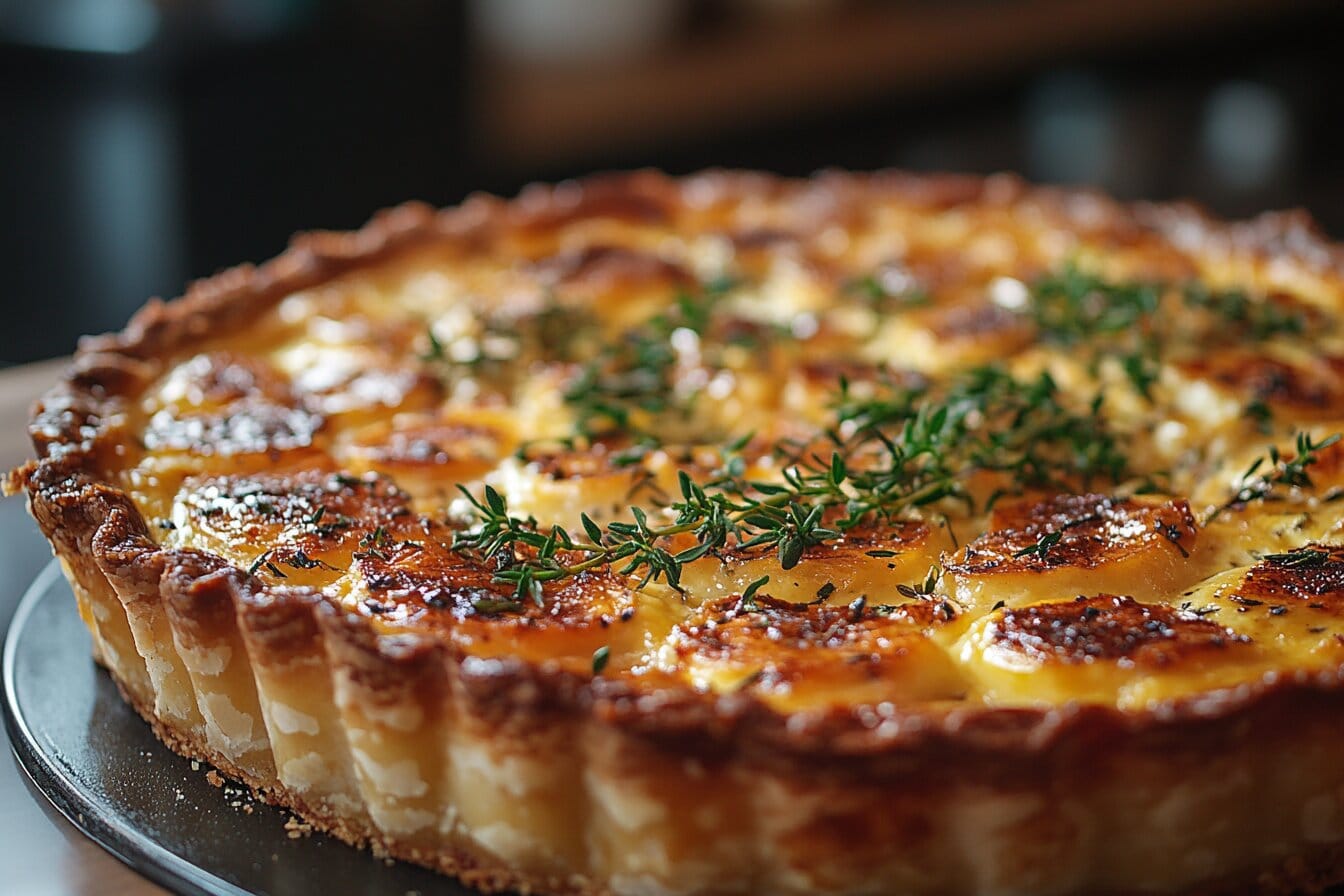Quiche is a popular dish that combines a flaky crust with a savory custard filling made of eggs, cream, cheese, and various add-ins like vegetables, meats, or seafood. It’s widely loved for its versatility and rich flavors, making it a staple in brunch menus, cafes, and home kitchens. However, when it comes to nutrition, the question often arises: Is quiche healthy or unhealthy?
The answer depends largely on the ingredients used, portion sizes, and how the dish is prepared. While quiche can be nutrient-rich and wholesome, it can also be calorie-dense and high in fats, which might raise concerns for those watching their weight or managing their health.
In this article, we’ll analyze quiche from every angle—its nutritional value, health benefits, and potential drawbacks. We’ll also explore ways to make healthier versions of quiche and compare it to other similar dishes. Whether you’re a quiche lover trying to stay healthy or just curious about its impact on your diet, this guide will help you make informed choices.

Understanding Quiche
What is Quiche?
Quiche is a savory French tart that traditionally consists of a pastry crust filled with a mixture of eggs, cream, cheese, and various other ingredients like meats, vegetables, or seafood. Originating in the Lorraine region of France, quiche has gained international popularity and is now a staple in brunch menus and home kitchens worldwide.
The most famous variety is the quiche Lorraine, made with bacon, eggs, cream, and cheese. Over time, numerous variations have emerged, including vegetarian and protein-rich options. Quiche can be served warm or cold, making it a versatile dish for any meal of the day.
Nutritional Components of Quiche
The nutritional value of quiche can vary depending on the ingredients used. However, a typical slice of quiche contains:
- Calories: Around 300–500 per serving, depending on the crust and fillings.
- Protein: 10–15 grams per slice, primarily from eggs, meat, and cheese.
- Fats: 20–30 grams, a mix of saturated and unsaturated fats.
- Carbohydrates: 20–30 grams, mostly from the pastry crust.
- Sodium: 400–700 milligrams, particularly in store-bought or pre-made quiches.
While quiche is rich in protein and fats, it is also calorie-dense due to the butter-laden crust and creamy filling.
Common Ingredients in Quiche
The healthfulness of quiche depends significantly on the ingredients used. Here are the most common components and their nutritional impact:
- Eggs: Eggs are a primary source of protein, vitamins like B12 and D, and essential minerals like selenium. However, they also contain cholesterol, which may concern individuals with high cholesterol levels.
- Cream or Milk: Heavy cream adds richness but also contributes saturated fats and calories. Substituting cream with milk or plant-based alternatives can lighten the dish.
- Cheese: Cheddar, Swiss, or Gruyère cheeses are often used in quiche, providing calcium, protein, and fats. However, cheese can be high in sodium and saturated fats.
- Pastry Crust: Made with butter or shortening, pastry crust adds refined carbs and significant calories. Alternatives like whole-grain or gluten-free crusts offer healthier options.
- Fillings: Fillings can range from nutrient-rich vegetables like spinach, tomatoes, and mushrooms to high-fat meats like bacon, sausage, or ham. Lean proteins and more vegetables make quiche healthier.
Health Benefits of Quiche

Rich Source of Protein
One of the significant benefits of quiche is its high protein content, thanks to the eggs, cheese, and any added meats. Protein is vital for muscle repair, energy, and overall body function. A single slice of quiche can provide up to 15 grams of protein, which is approximately 25% of the daily recommended intake for most individuals.
For individuals looking to increase their protein intake, quiche can be an excellent option—especially if prepared with lean meats like turkey, chicken, or seafood instead of fatty processed meats.
Good Fats and Essential Nutrients
Quiche contains both saturated fats and unsaturated fats, depending on the choice of ingredients. Eggs and cheese are sources of healthy fats, which help in nutrient absorption, brain function, and hormone regulation. Quiche also provides:
- Vitamins: B vitamins (B12, B6, and folate) and fat-soluble vitamins like A, D, E, and K.
- Minerals: Calcium, magnesium, iron, and phosphorus, essential for bone health and overall body function.
While it’s true that quiche contains fats, not all fats are bad. Incorporating healthy fats like those found in eggs, nuts, or avocado into your quiche can improve its nutritional profile.
Customizable for Healthier Options
Quiche is one of the most versatile dishes, allowing you to adjust the recipe for your dietary needs:
- Replace the crust with a crustless version to reduce carbs and calories.
- Add leafy greens like spinach, kale, or Swiss chard for fiber and antioxidants.
- Use plant-based milk or Greek yogurt instead of heavy cream to lower the fat content.
- Include lean proteins like turkey sausage, chicken, or tofu for a healthier alternative to bacon or ham.
By making mindful ingredient choices, quiche can become a nutritious and balanced meal that suits various dietary preferences.
Potential Health Concerns of Quiche
High in Calories and Fats
One of the primary concerns with traditional quiche is its high-calorie content and significant fat levels. The buttery pastry crust, creamy filling, and cheese all contribute to these factors. For instance:
- A single slice of traditional quiche can contain between 400–500 calories, making it a dense meal option.
- The heavy cream and cheese add saturated fats, which, when consumed in excess, can contribute to heart disease, obesity, and high cholesterol levels.
For individuals following a calorie-restricted or heart-healthy diet, consuming traditional quiche regularly may not be ideal. However, modifications like crustless quiche, low-fat dairy, and healthier fillings can make it more suitable.
Sodium Content in Store-Bought Quiches
Store-bought or pre-made quiches often contain high levels of sodium to enhance flavor and increase shelf life. A single slice of commercially produced quiche can contain anywhere between 500–700 milligrams of sodium, which is nearly a third of the daily recommended intake for most adults.
Excess sodium can lead to health issues such as:
- High blood pressure (hypertension)
- Fluid retention
- Increased risk of heart disease and stroke
To reduce sodium intake, preparing quiche at home allows you to control the salt content and use fresh, low-sodium ingredients like vegetables and lean meats.
Refined Carbs from Pastry Crust
The classic quiche crust is made with white flour, butter, or shortening, which provides refined carbohydrates and unhealthy fats. Refined carbs:
- Offer little nutritional value compared to whole grains.
- Can cause blood sugar spikes, particularly for individuals with diabetes or insulin resistance.
For health-conscious individuals, alternatives like whole-grain crusts, almond flour crusts, or even crustless quiches are excellent ways to cut back on refined carbs while still enjoying the dish.
How to Make a Healthier Quiche
Using Whole-Grain Crust
Replacing the traditional pastry crust with a whole-grain crust provides added fiber, vitamins, and minerals while reducing the glycemic impact of the meal. Whole-grain options can:
- Improve digestion due to their higher fiber content.
- Help manage blood sugar levels.
- Keep you feeling full for longer.
For those following gluten-free diets, almond flour or oat-based crusts are great alternatives.
Adding More Vegetables
Incorporating vegetables into your quiche not only adds flavor but also increases the dish’s nutritional value. Vegetables are rich in fiber, vitamins, and antioxidants that promote overall health. Popular options include:
- Leafy Greens: Spinach, kale, and Swiss chard provide iron, folate, and vitamin K.
- Bell Peppers: High in vitamin C and antioxidants.
- Mushrooms: A great source of vitamin D and immune-boosting nutrients.
- Tomatoes: Provide lycopene, an antioxidant linked to heart health.
The more vegetables you add, the healthier and more satisfying your quiche becomes.
Choosing Lean Proteins and Dairy
To cut back on saturated fats, replace high-fat meats like bacon and sausage with leaner protein options, such as:
- Turkey bacon or turkey sausage
- Grilled chicken or turkey breast
- Smoked salmon
- Plant-based proteins like tofu or tempeh
For dairy, swap heavy cream with lighter alternatives like:
- Low-fat milk
- Greek yogurt for added protein
- Plant-based milk like almond, soy, or oat milk
These substitutions help maintain the creaminess of the quiche while reducing calories and fats.
Reducing Sodium and Fats
To further make quiche healthier:
- Use low-sodium cheese or reduce the cheese quantity.
- Avoid processed meats like ham or bacon, which are high in sodium.
- Season your quiche with herbs, spices, and garlic instead of salt to enhance flavor naturally.
By focusing on fresh, nutrient-dense ingredients, you can transform quiche into a well-balanced, health-friendly dish suitable for regular consumption.
Comparing Quiche to Other Dishes
Quiche vs. Frittata
While quiche and frittata are both egg-based dishes, they differ significantly in terms of preparation and nutritional profile.
- Crust:
- Quiche: Typically includes a buttery crust, which adds refined carbs, fats, and extra calories.
- Frittata: Is crustless, eliminating unnecessary carbs and fats, making it a lower-calorie option.
- Dairy Content:
- Quiche: Made with heavy cream or whole milk, contributing to a richer texture but also adding more saturated fat.
- Frittata: Usually made with a small amount of milk or none at all, reducing overall fat content.
- Calories:
- A slice of quiche can contain 400–500 calories.
- A similar portion of frittata contains 200–300 calories, depending on ingredients.
Conclusion: For those seeking a lighter, low-carb alternative, frittata is the healthier choice. It delivers similar flavors and nutrition without the additional fats and carbs from the crust.
Quiche vs. Omelet
Omelets are another popular egg dish often compared to quiche. Here’s how they stack up:
- Preparation:
- Quiche: Baked in the oven with a custard-like texture.
- Omelet: Cooked quickly on a stovetop and served immediately.
- Ingredients:
- Quiche: Combines eggs, cream, cheese, and a crust, often making it heavier.
- Omelet: Usually contains eggs and fillings like vegetables, cheese, or meats, without cream or crust.
- Nutritional Value:
- A standard omelet contains fewer calories (about 150–250 per serving) because it omits the crust and heavy cream.
- Omelets are also lower in fat and carbs, making them ideal for weight-conscious or low-carb diets.
Conclusion: While quiche is a great dish for special occasions, omelets are the healthier everyday option due to their lower calorie and fat content.
Frequently Asked Questions
Is Quiche Suitable for Weight Loss?
Quiche can fit into a weight loss diet if prepared with healthy ingredients. Opt for crustless quiche, include plenty of vegetables, and use low-fat dairy and lean proteins. These adjustments significantly reduce calories while maintaining flavor.
Can Quiche Be a Healthy Breakfast?
Yes, quiche can be a nutritious breakfast option, especially when packed with vegetables, lean proteins, and made with a healthier crust (or no crust). It provides protein, vitamins, and minerals that keep you full and energized throughout the morning.
How Many Calories Are in a Typical Quiche?
A standard slice of quiche contains between 400–500 calories, depending on the ingredients. Reducing cheese, using low-fat milk, and skipping the crust can bring this number down to around 200–300 calories.
What Are the Healthiest Ingredients for Quiche?
To make a healthy quiche:
- Use a whole-grain or almond flour crust or skip the crust altogether.
- Incorporate nutrient-rich vegetables like spinach, tomatoes, mushrooms, and peppers.
- Use lean proteins like turkey bacon, chicken, or tofu.
- Replace heavy cream with Greek yogurt, low-fat milk, or plant-based milk.
Can I Eat Quiche on a Low-Carb Diet?
Yes, quiche can be low-carb if you remove the crust and focus on eggs, vegetables, and protein. A crustless quiche significantly reduces carbohydrate content while keeping the dish high in protein and nutrients.
Conclusion
Quiche can be both healthy and unhealthy depending on its ingredients and preparation. While the traditional version is rich in calories, fats, and refined carbs due to its buttery crust and creamy filling, it also offers a solid source of protein, essential nutrients, and versatility. By making a few modifications—like using a whole-grain or crustless base, adding vegetables, choosing lean proteins, and replacing heavy cream with low-fat dairy—you can transform quiche into a healthier, nutrient-dense meal suitable for various diets.
For those aiming to lose weight, improve heart health, or simply enjoy a balanced diet, quiche can be a part of your meal plan when prepared mindfully. Ultimately, whether quiche is healthy or unhealthy comes down to the choices you make in the kitchen.

